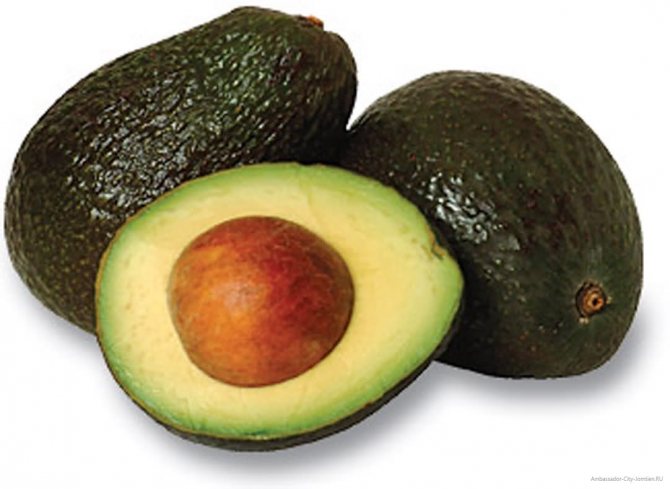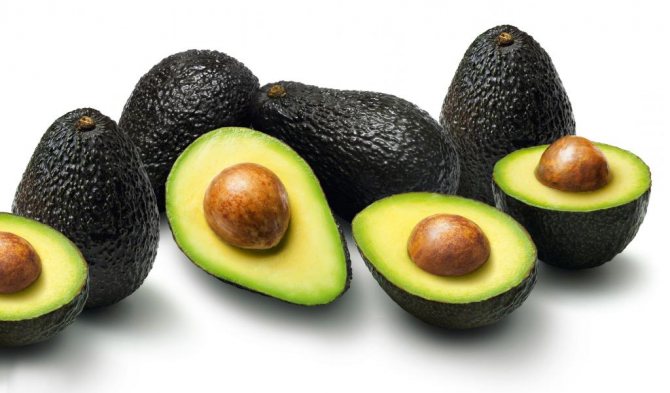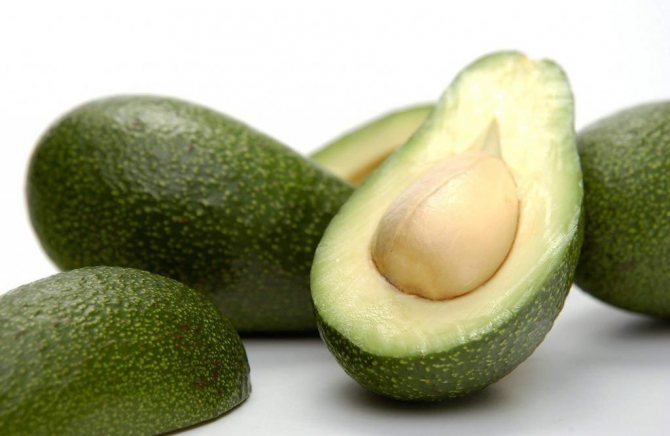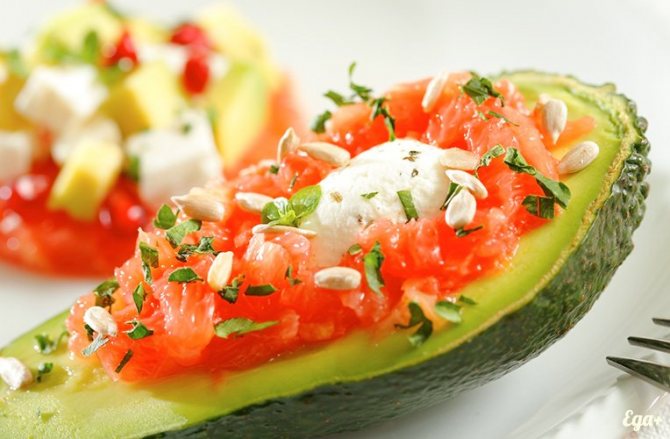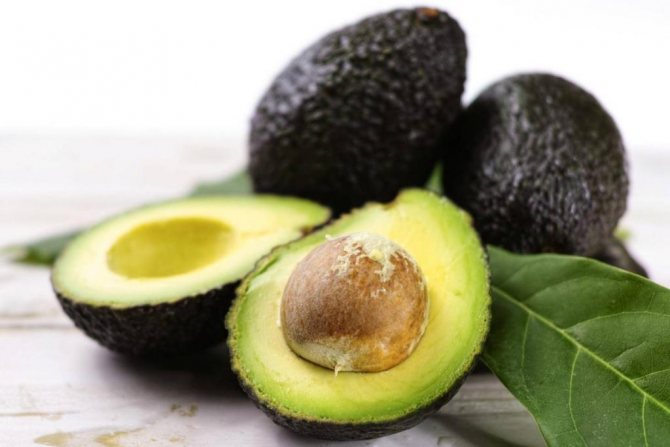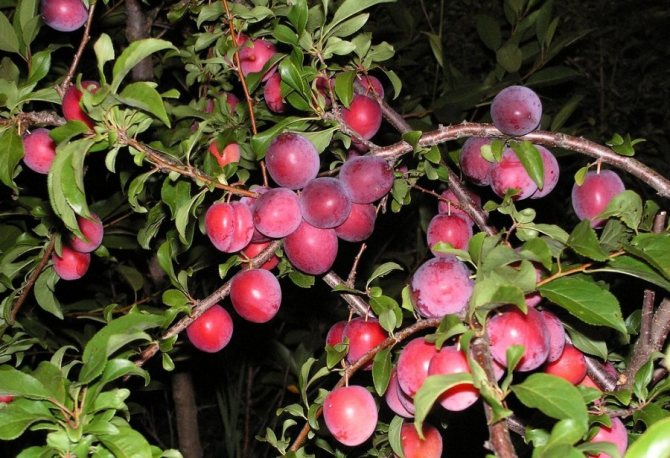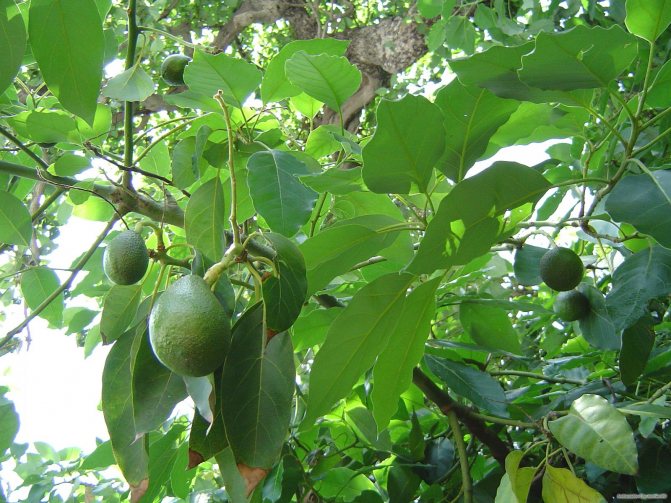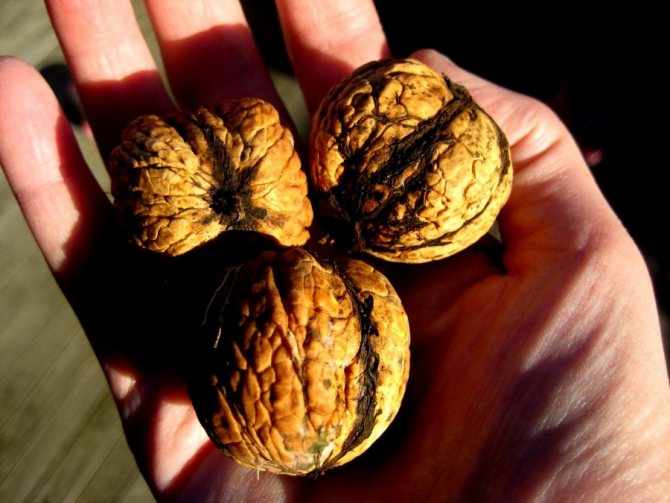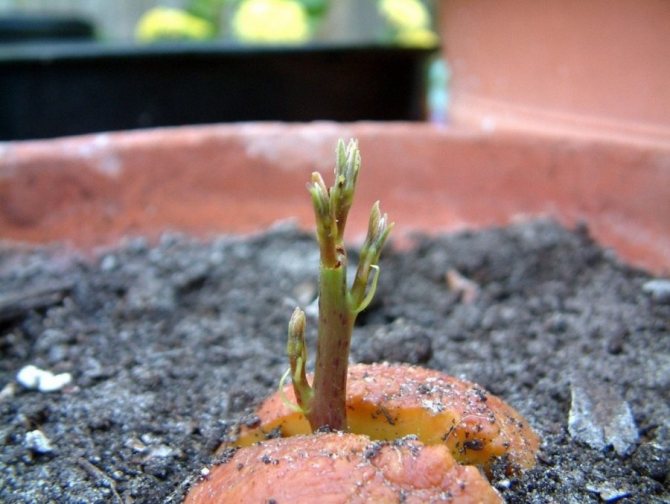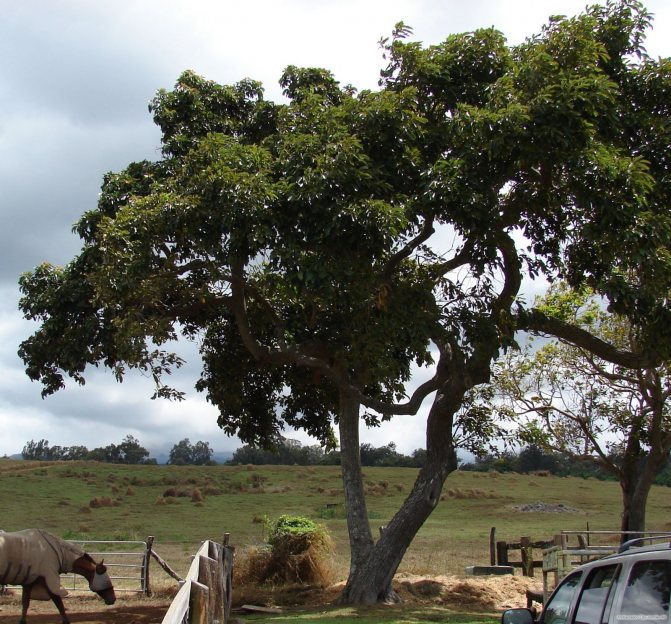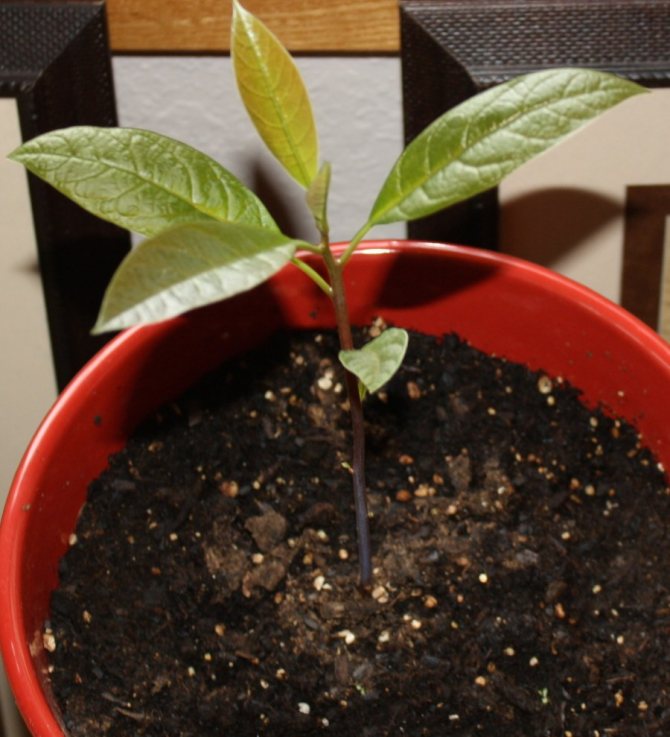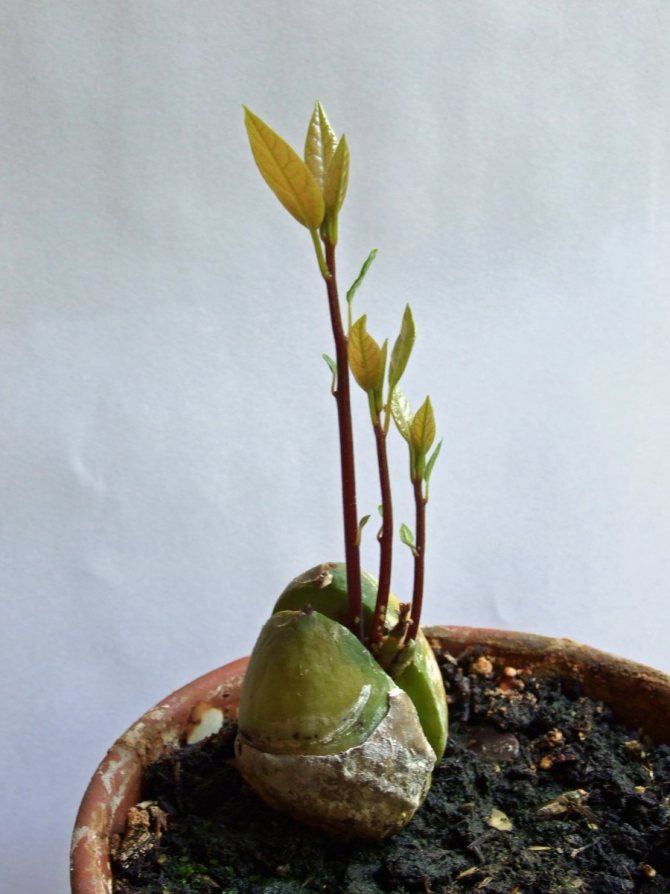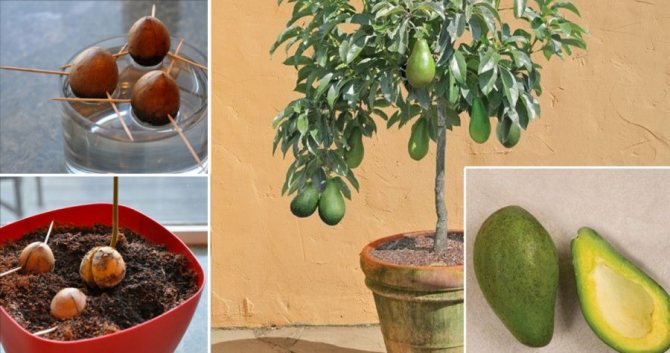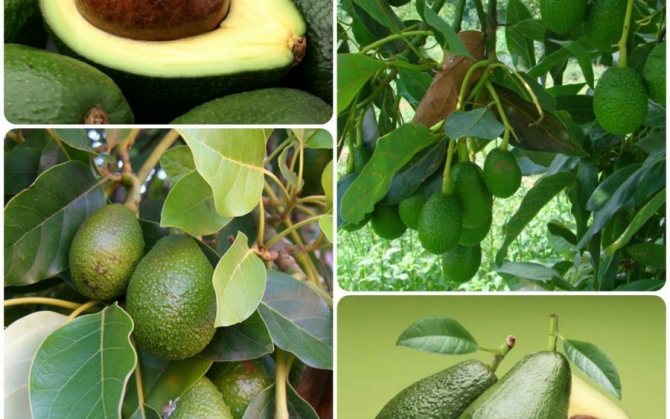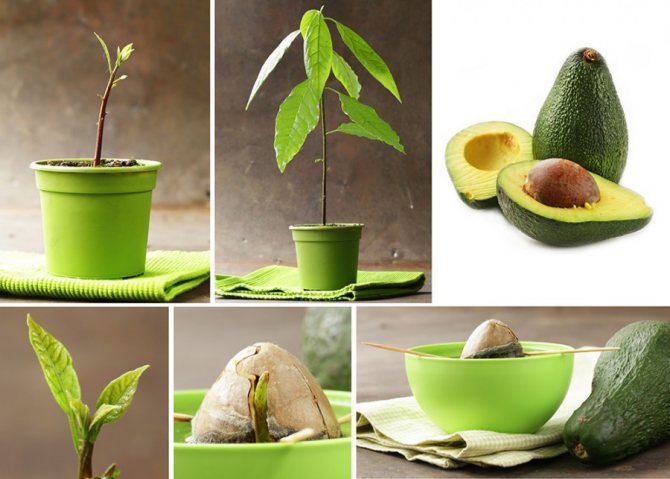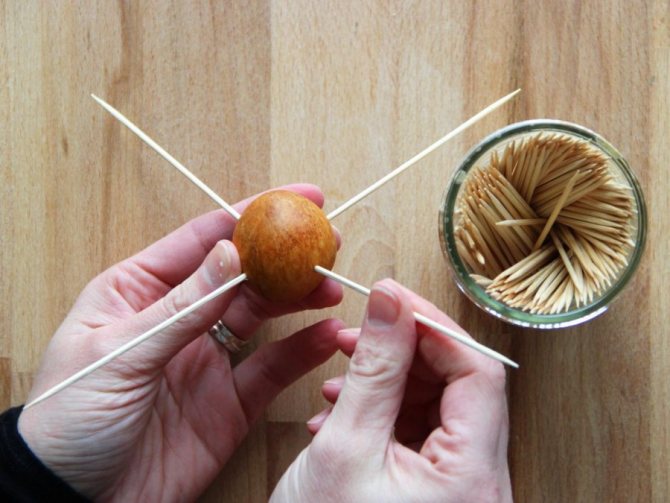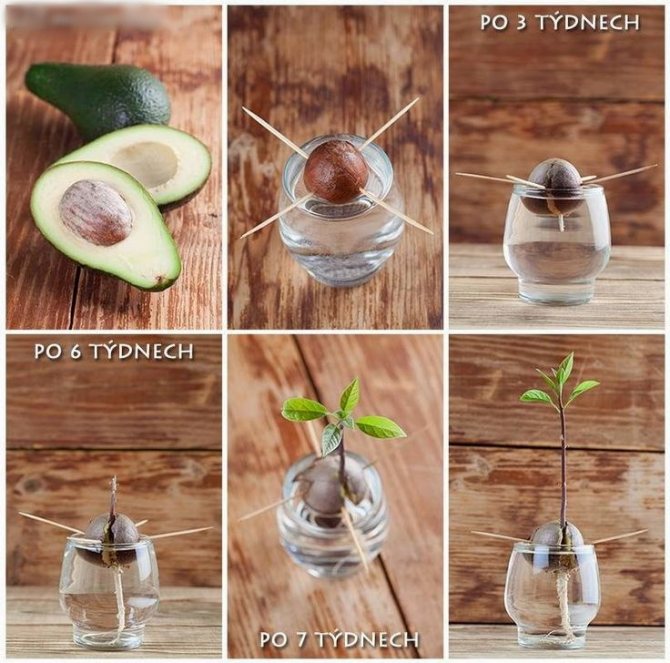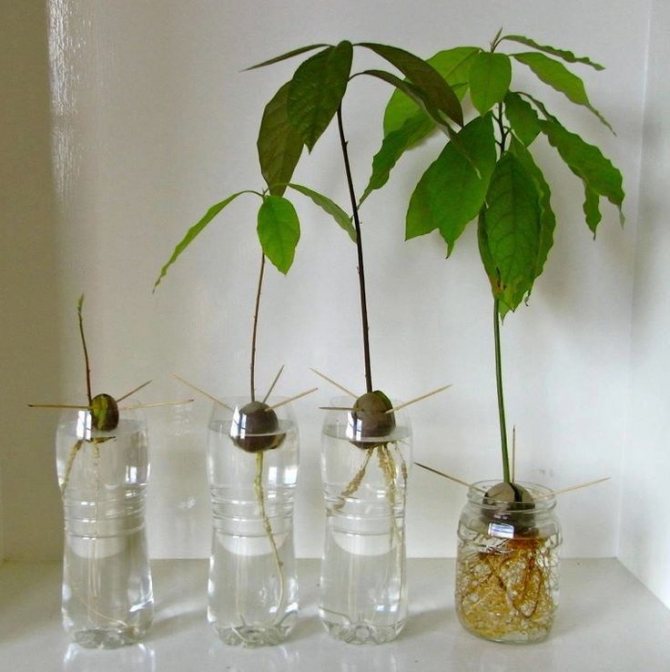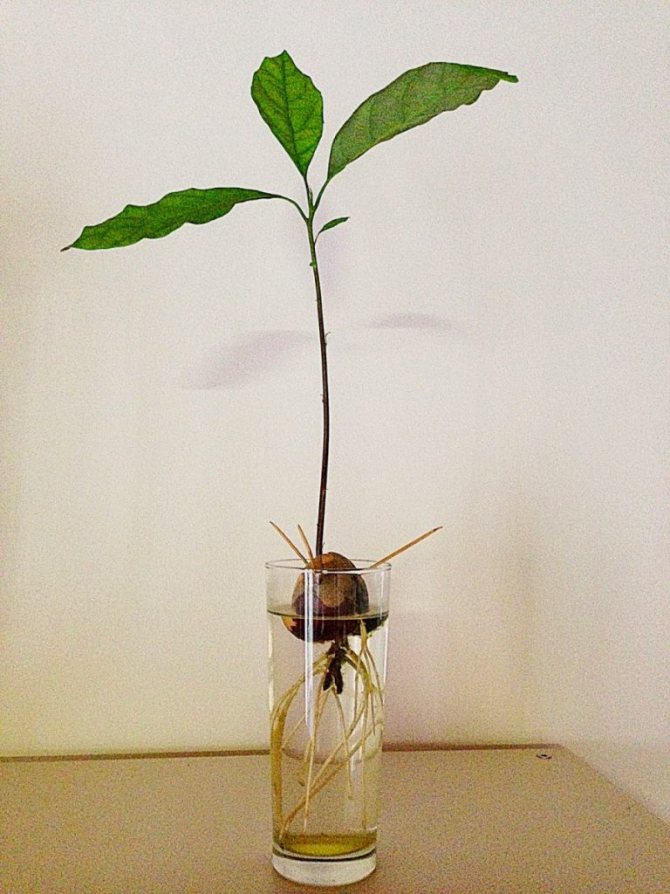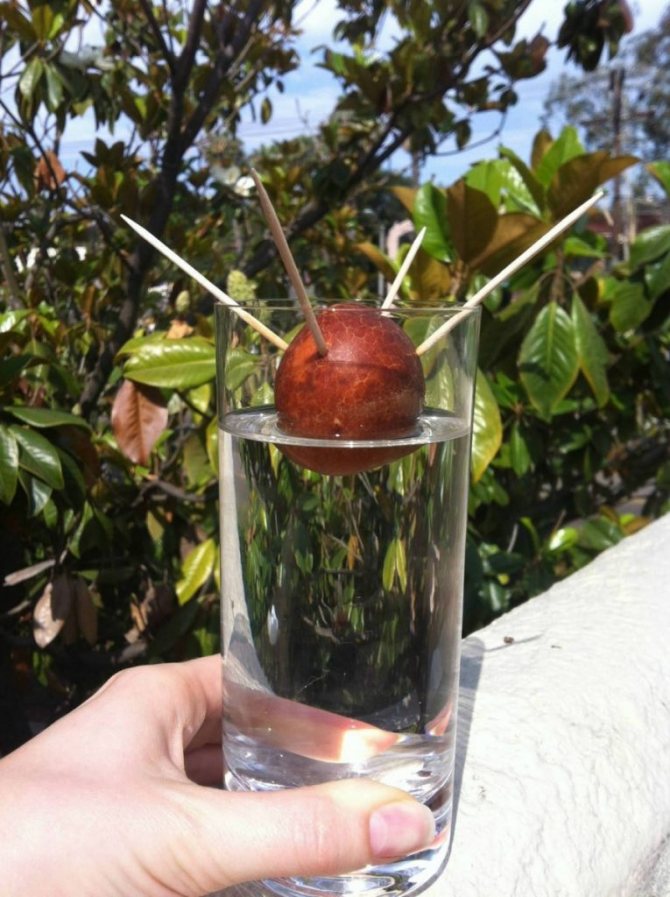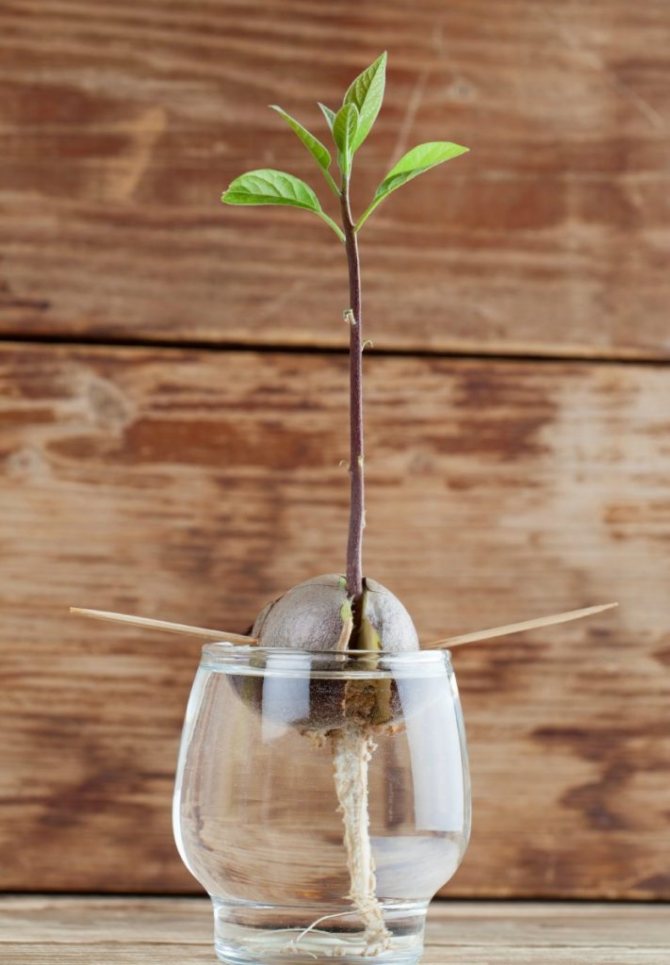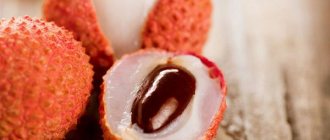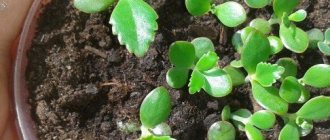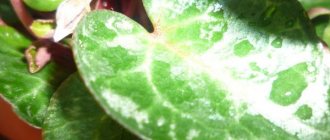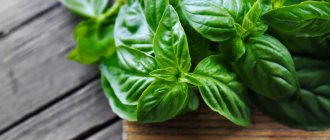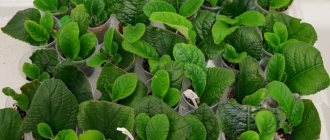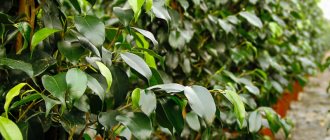03/08/2019 306 Tree
When grown at home from seed, the tropical fruit sprouts 99 out of 100 times. The tree will bear fruit only if it is properly organized for its care and suitable conditions of the space around. You can sprout an avocado from a seed in any convenient way.
[Hide]
What is Avocado
Avocado has appeared on store shelves for a long time. Finding it in the supermarket is no problem. At the same time, it remains an exotic product, the origin of which is not known to everyone.
Avocado is a fruit, as strange as it sounds. It grows on a tree bearing the same name. The tree originates in the laurel family. Its height can reach 20 meters, but there are almost 400 varieties of fruit. Some of them are edible, but others are better not to be eaten.
The avocado looks like an ordinary pear. Differs in the color of the peel. It comes in green, red and purple. The fruit tastes like pumpkin with a nutty flavor. During the ripening process, it tastes differently. The fruits themselves, eaten, weigh no more than 300 grams. Half of the weight comes from the bone in the very center. It is not worth trying, it contains toxic substances. But the pulp of the fruit has beneficial properties. The consistency of a ripe avocado resembles butter, with a rather oily pulp.
Zutano
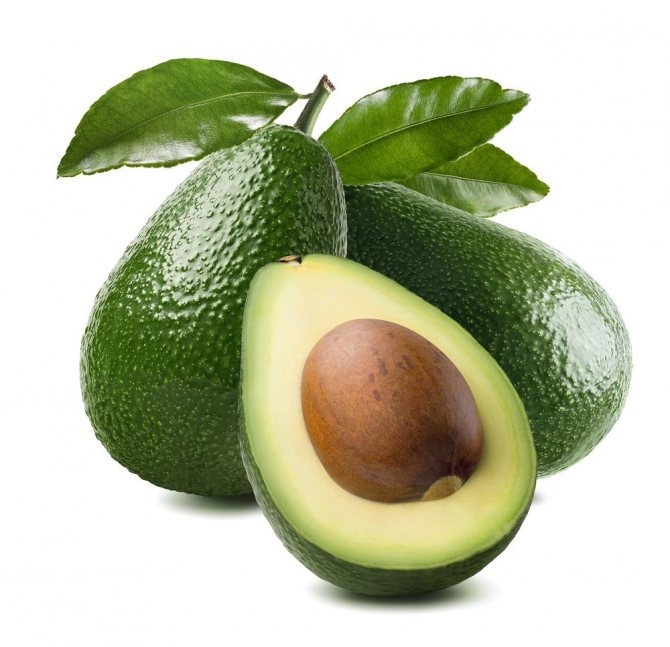
This is a Guatemalan type of avocado. The rind has a fine and shiny texture and a yellow-green color. This color remains unchanged throughout the entire ripening period. Fruits are harvested throughout the autumn period, right up to winter.
The inside is flesh, soft and slightly watery, light green in color. The stone is large enough for the relatively small size of the fruit itself - 450 g, this is the best option.
How to germinate an avocado seed in water
To do this, place the avocado seed in half in water. It should be noted that it should be located with the sharp side up. It is the blunt lower part that later gives the roots of the plant. You can put it in a container and fill it with water to the desired level, or you can use this method.
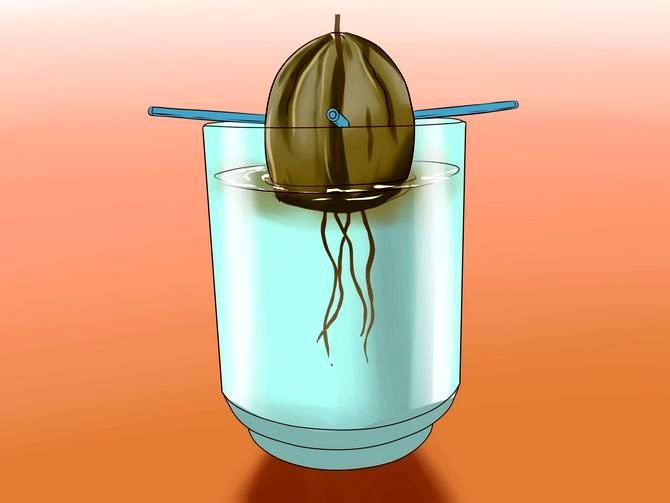

Photo: We grow avocados from the seed at home
Several toothpicks are taken, with which you need to very carefully pierce the bone. The depth of the punctures should be small, half a centimeter is enough. After that, it must be immersed in a container filled with water. So, the bone will be covered with water at the required level - exactly to the middle. It is better to store the bone on a windowsill in a warm, sunny place.
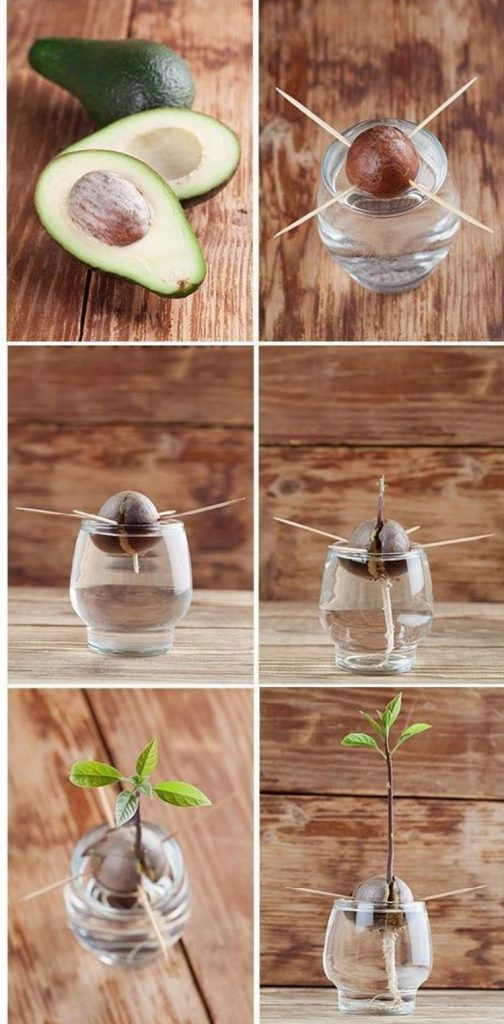

Photo: We grow avocados from the seed at home
It is necessary to add water daily to the same level as at the beginning. Water must first be defended and monitored by its temperature, it should be 25-27 degrees.
If the bone is submerged in water using toothpicks, it is important that no water gets into the punctured areas.
Tip: To speed up the process of seed germination, you can pre-peel the skin in the part that is immersed in water.
After a few weeks, a sprout forms at the bone.The time of its appearance will depend on the season in which germination takes place. Avocados, like other plants, are positively affected by the sun's rays. The more sun the plant receives, the better for it.
After the roots grow to a length of 3-4 cm, you can transplant the avocado into the soil.
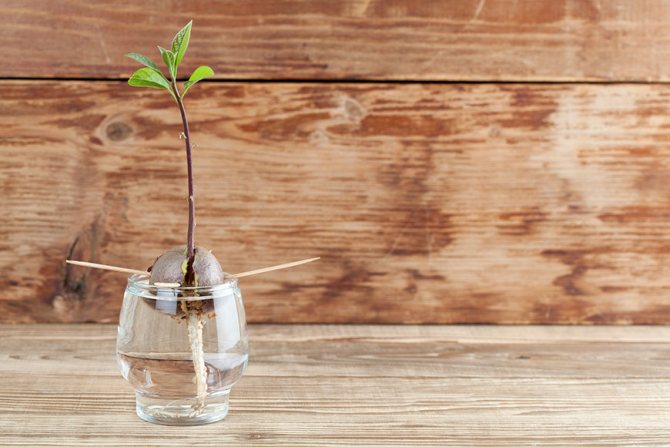

Photo: We grow avocados from the seed at home
Region of origin
Mexico is considered the birthplace of this tropical plant. The berry was eaten by the ancient Aztecs who lived in that region. Over time, they began to cultivate the plant. Scientists during excavations found seeds that were larger in size than those of wild specimens.
Description
Compared to most berries, the "alligator pear" is significant in size. The average length is 5-20 cm. The weight of one specimen can be either 50-150 g or 1 kg. The shape is varied - from oval to pear-shaped. The photo shows different types of avocados.
The rind is usually dark crocodile green. Young specimens are distinguished by lighter shades. As they ripen, the rind of most varieties darkens to black.
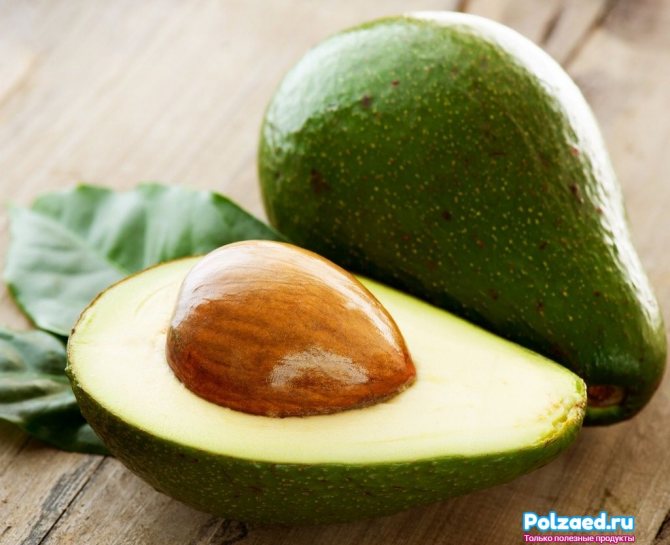

Varieties
There are about 1000 varieties of avocado. They differ in the territory of growth, appearance, and also in taste. Only three species have gained particular popularity: Mexican, Guatemalan and West Indian. Let's consider in more detail their signs.
Mexican
The main feature is endurance. Trees tolerate low temperatures very well. They bloom in spring, bear fruit in summer and autumn. The rind is smooth and thin, easily separated from the pulp.
Guatemalan
Trees of this species also bloom in the spring, but the fruits should be expected only next year. One of the main features is the thick, dense skin. This species is resistant to light frost.
West Indian
Flowering of this species occurs in the spring, the fruits can be obtained in the summer of the same year. The rind is thin and smooth. West Indian species weakly resistant to frost.
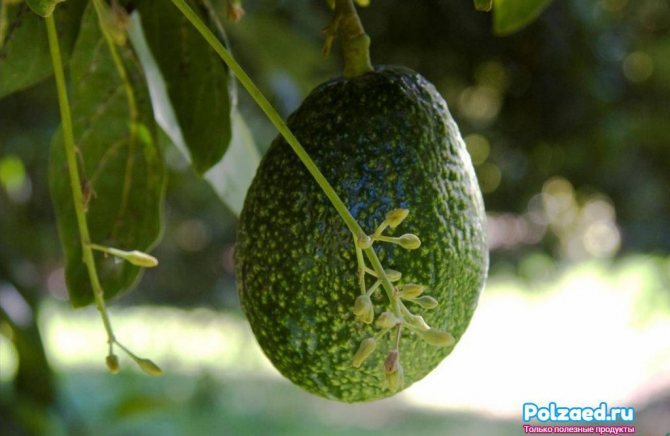

Various varieties
Among many other varieties, not all are widespread. They became the favorites of many culinary experts because of their taste. Consider the varieties that are most often found on supermarket shelves:
- "Bacon". Typically, specimens are oval. Their sizes are small, and their weight rarely exceeds 360 g. The seeds are medium and large. The pulp has a pale yellow tint. They are popular for their unobtrusive and light taste. The rind is green, thin, smooth, easy to peel. Over time, it darkens a little;
- "Gwen." These are usually medium to large oval fruits. Weight ranges from 200-450 g. The stone is round, small. Golden green pulp with pleasant creamy taste. The rind is thick, pimply, and soft to the touch. After ripening, it acquires a rich green color;
- "Zutano". Pear-shaped berry. It tastes a bit like an apple;
- Carlsbad. The berries of this variety are usually medium in size, oblong, ovoid. Often they reach a weight of 450 g. The rind is not very thick, dark green. Over time, it becomes brown or even black. The bone is round and takes up about 15% of the weight. Differs in excellent unobtrusive taste;
- "Mexico". This variety is considered one of the most frost-resistant varieties. It tolerates periods of drought well. The weight of an average specimen is about 100 g;
- Pinkerton. The berries are large, have an elongated pear-shaped shape. Some specimens reach a weight of 560 g or more. The rind is thick, deep green, slightly rough. This variety has a high oil content. The stone is small, takes up no more than 10% of the total mass;
- Puebla. Trees of this variety are distinguished by high indicators of frost resistance.The average weight of the fruit is 200 g. The peel is dark brown;
- Reed. Round or oval shape. Very large specimens reach a weight of 500 g. The pulp has a light yellow tint. It is appreciated for its excellent taste. Light unobtrusive shades of walnut and pear are felt;
- Fuerte. Trees bear fruit in winter. Average weight is about 250 g. Rich green peel of medium thickness, smooth. It can be easily separated from the pulp. Over time, the peel does not change color like most varieties. Gourmets love Fuerte for its sweet taste;
- Hass. Large fruits, reaching 560 g. The shape is oval, the rind is thick, black. The pulp is white or yellowish, slightly oily. Pronounced nut flavor;
- Ettinger. It is considered one of the most delicate varieties. The pulp is so soft that it melts in your mouth.
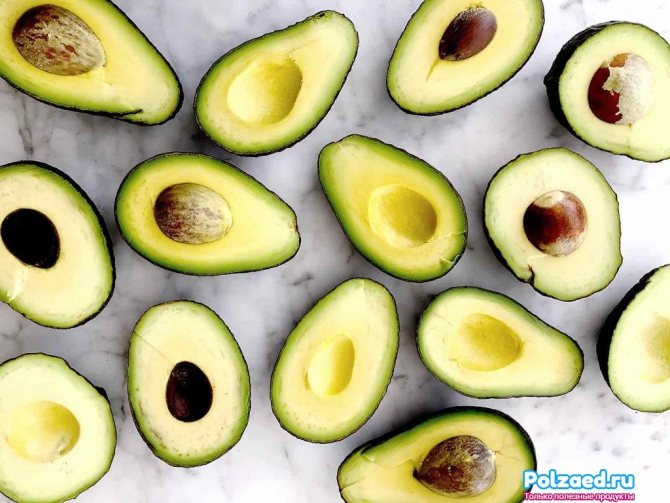

The above varieties differ in morphology, region of growth and taste. For example, the Ettinger variety is grown primarily in Israel. Usually this plant is cultivated in tropical and subtropical zones.
back to menu ↑
What soil should be chosen for germinating avocado
This issue must be approached with full responsibility. You cannot plant avocados in absolutely any soil. This plant does not take root well in an acidic environment. The best choice would be flower soil, which is available at any gardening store or large supermarket. This land has already been prepared in a special way, fertilized, and for better growth of the future avocado tree, it would be ideal to mix it with peat and sand.
You also need to ensure that the bone has the ability to breathe in the soil. Therefore, you need to make sure that the soil is loose enough, and also remember to add drainage to it.
Pinkerton
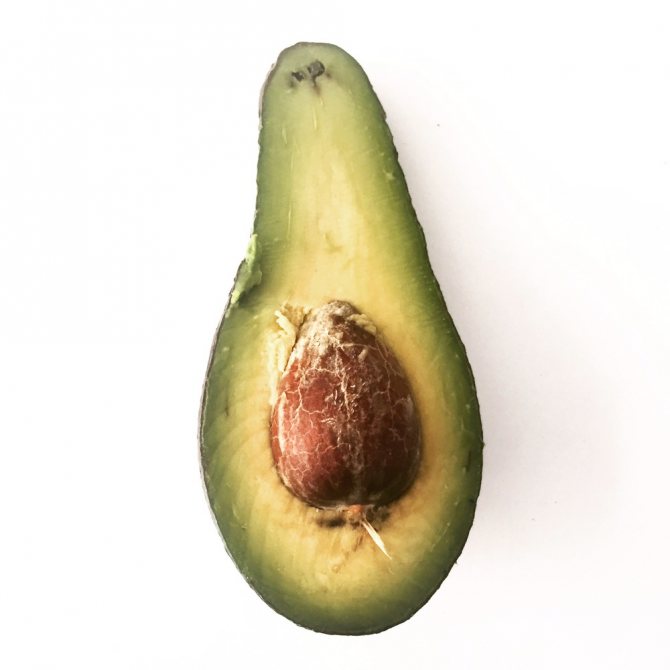

This is one of the hybrid varieties of avocado - pinkerton. It has an elongated pear-shaped shape. The fruits are large enough and reach more than 550 g. Relatively large fruit sizes, the seed is small and occupies no more than 10%. The rind is dark green in color and has a rough texture. The more ripe the fruit, the richer its color. The inside is creamy and the flesh is light green. This variety is famous for its high oil content. The inside is easy enough to separate from the peel. Fruits ripen in summer and autumn.
Choosing an avocado seed pot
In addition to the soil, due attention must be paid to the pot in which our tree will grow. For the initial planting, a small pot is selected. A 10 cm deep is fine.
There must be several holes at the bottom of the pot. They allow unnecessary moisture to pass through. If this condition is neglected, rotting of the plant roots may begin. This can cause the death of your future tree. For the same reason, drainage is laid at the bottom of the pot, a couple of centimeters high. For this purpose, you can use expanded clay or special drainage granules. Drainage will remove excess water from the roots of the plant and will serve as an excellent means for aerating the soil.
When it comes to pot material, we recommend sticking with plastic. Earthenware or ceramic should not be chosen for this fruit tree. Subject to all the above conditions, the avocado bone will be very comfortable and very soon it will definitely sprout.
Beneficial features
A lot can be said about the benefits of avocado for the body. It is not for nothing that this is one of the most recommended food products for serious pathologies. Constant use helps to normalize the work of all systems, improves the functional state of the body as a whole.
Doctors advise eating the berry raw if you have heart problems. Regular use avoids anemia by increasing the production of red blood cells. Over time, the work of the cardiovascular system normalizes.Often, avocados are eaten for weight loss: the intake allows you to speed up the metabolism, which is why a person quickly loses weight.
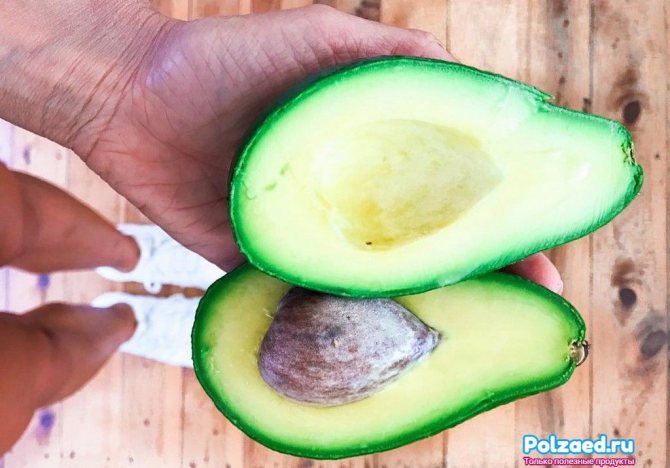

back to menu ↑
Germinating avocado seeds in the ground
Germinating a bone in water is a very entertaining and visual activity. Here the whole process takes place before our eyes. But you can use another method to grow an avocado from a seed. Plant her directly into the ground. This option is less troublesome, but it will take much longer before the first shoots appear.
It is better to plant avocados in the spring. This is especially true for this method of germination (into the ground). This is due to the fact that at this time of the year the sun's rays are the most favorable, which help the sprout to break out of the bone.
A large pit is best for planting avocados in the ground. She is more capable of a quick emergence of the plant. When immersing a bone in the soil, its upper part must be left above the ground. This should be the pointed side of the bone. Accordingly, the widest part will be in the ground.
The planted bone must be transferred to a bright place. Watering should be carried out weekly in large quantities. It is worth checking the soil and not letting it get dry. It is better to water the avocado with filtered water, with the addition of a small amount of salt (2-3 pinches).
A seed planted in this way will sprout no earlier than 3-3.5 months after planting.
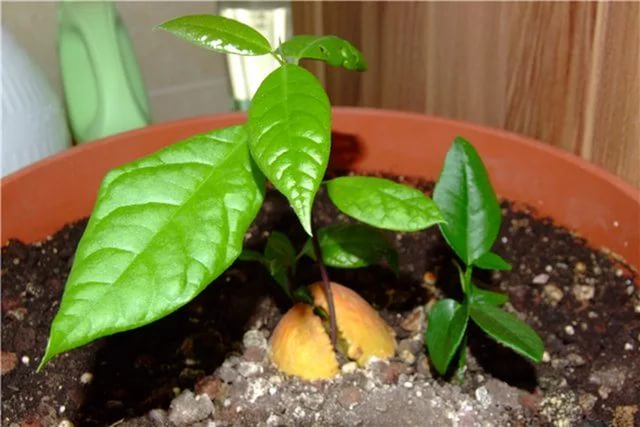

Photo: We grow avocados from the seed at home
Possible problems and their elimination
Avocados can attack ticks and scale insects.
To eliminate them, you can use the following measures:
- Washing the leaves with a solution of water with the addition of laundry soap.
- Chamomile solution. Bring 200 grams of flowers (per glass of water) to a boil and stand for at least 10 hours. Pass through a fine sieve and add water so that twice the infusion is obtained. It can be processed undiluted if the Perseus is badly damaged.
- Garlic solution. Finely chop half a kilogram of vegetable crop and add to water (about 3 liters). Then we place the tincture in a dark place for 5 days. We filter and add 10 liters of water for every 60 ml of infusion. In a diluted product, you can rub 50 g on a coarse grater. hozmyla.
- You can buy ready-made medications at flower shops. They are used for large-scale infection of the Persea with American ticks.
You should be aware that moisture in the air and spraying or rinsing tree leaves with running water is the best way to prevent pest infestation.
Tree care
Avocados are native to the tropics. This means that you need to create warm and humid conditions for it. The temperature in the room is maintained at least 22-25 degrees Celsius. It should be very light. However, direct rays of the sun should not be allowed to reach the leaves of the plant. This can cause burns on them.
If the avocado endures a cold snap or, conversely, overheats, the leaves from the plant may crumble. This is not a reason to throw it away. Renew your comfort and foliage will soon reappear on the tree.
It will be good to support the vital activity of the tree by spraying the leaves from a spray bottle with water. It is best to do this as often as possible. You also need to put a pallet under the pot with a tree, which must be filled with water.
If the tree is oversaturated with water, the leaves of the avocado will turn yellow. If it is lacking, it will turn brown.
Avocados are fertilized once a month on average. For feeding, you can use any complex mineral fertilizers. If this procedure is done in a timely manner, the tree will develop quite actively.
The most active growth time is considered to be 3 months after the formation of leaves. By the end of the third month, the tree will already be 50-55 cm high. After that, its growth slows down a little.Once the avocado reaches the height you want, you need to pinch the top.
Each year, you need to select a larger pot for the avocado and replant it. This is done in mid-spring using the transshipment method. It will be good to add clay and compost to the soil. But an adult avocado (over 5 years old) does not need to be transplanted more often than once every 2 years. It is better not to stress him unnecessarily with the transplant unless necessary.
Semil-34
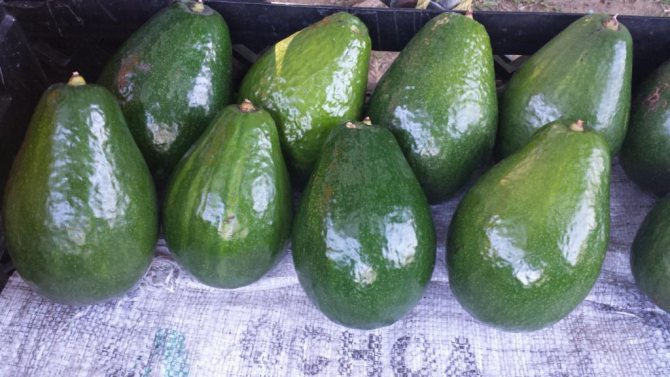

This variety is more exotic and expensive, it is, so to speak, a premium class. Outwardly, the fruit is similar to a ball, has a more oval shape. Reaches an impressive size - an average of about 1 kg. Despite the fact that only the pulp is almost 70%. It is grown in the Dominican Republic, but despite the hot climate from which it is delivered to all corners of the world, Semil-34 is surprisingly frost-resistant. Stored for a long time at various temperatures.
Just like other varieties of avocado, semil-34 has a degree of ripening, while its taste changes. When fully ripe, the fruit has a pleasant sweetish flavor with a fruity note. Endowed with increased juiciness, it is consumed simply as a fruit. But for guacamole, a less suitable option can only spoil the dish due to the increased moisture content.
All varieties are slightly similar to each other and due to the property of changing their taste during ripening, it can be easily confused with other varieties. For example, if you give Semil-34 to overripe, then it is almost impossible to distinguish it by taste from the Hass variety. The texture becomes buttery and takes on a nutty flavor, and the flesh takes on a bright yellow color.
Avocado fruit
Many who are interested in the question of how to grow an avocado from a seed pursue the goal of obtaining fruits. At home, this is possible. In the third year, the avocado has flowers.
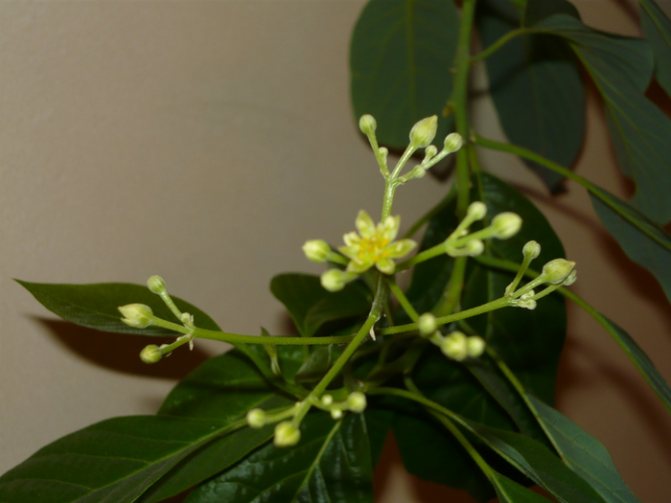

Photo: We grow avocados from the seed at home
They look like a yellow-green bunch. For pollination to occur, you need to grow another tree. Then they can cross-pollinate. This procedure is performed with a soft brush three times a month. Mature pollen is removed from the blossoming flowers and transferred to the flowers of another avocado tree. These actions are best done in an early sunny morning.
Growing a few avocado trees at home can accomplish another goal. If you germinate 2 or 3 seeds in one pot, the stems can be intertwined. This weaving is done carefully, without damaging or breaking the stems of the plants. It looks very impressive.


Photo: We grow avocados from the seed at home
Fuerte
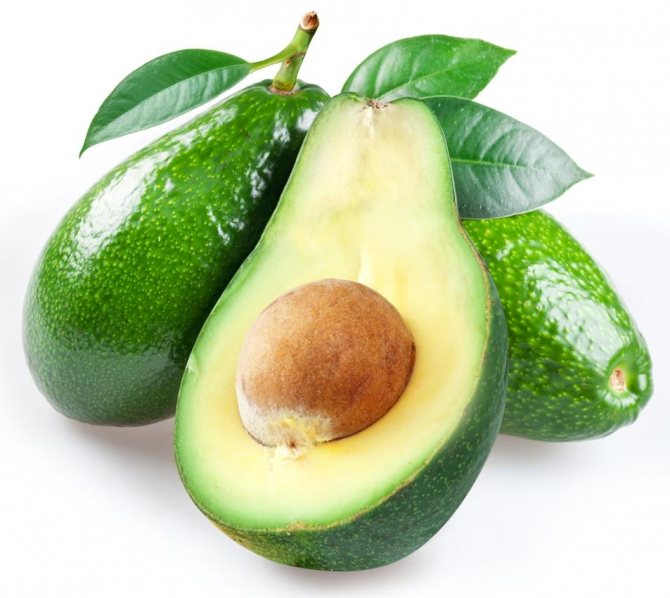

Outwardly, this variety of avocado has a more elongated shape, the skin is smooth and has a light green color, and the inner stone is small. The pulp, depending on the country of cultivation, can be light white or yellow, has a high fat content and is very pleasant to the taste.
It is grown in many countries and, interestingly, in each country the taste of this variety is quite different from each other.
Fruits ripen in summer and autumn. In transportation it is problematic and unstable.
Cooking use
Avocados are widely used in cooking. Unlike other fruits, which are primarily great for making desserts, this fruit is ideal for making sauces and salads.
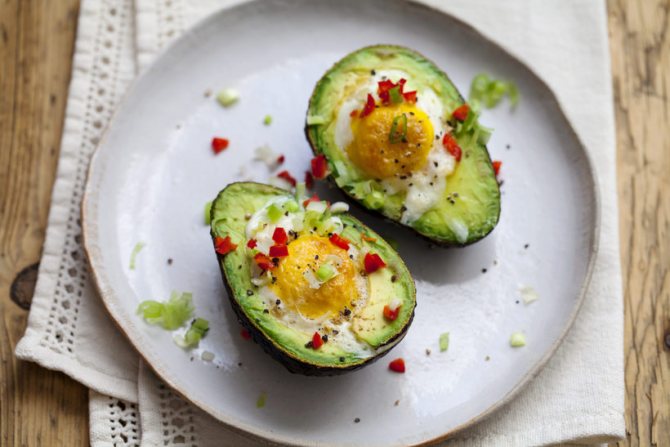

When making dishes using an alligator pear, you need to know a few simple rules:
- Fruits are usually sold a little unripe, so before cooking they need to be kept for several days in a dark, warm place;
- When interacting with oxygen, the pulp of the fruit undergoes rapid oxidation and acquires a very unpresentable, dark color. To avoid this, it must be sprayed with lemon juice;
- Unripe pulp is hard and tasteless, so only ripe fruit should be used.
The alligator pear is very popular among vegetarians. In their dishes, they use the pulp of this fruit instead of meat. And such common Japanese dishes as sushi and rolls are increasingly being prepared with the addition of this avocado.
Planting and transplanting
For the first time, the avocado is planted from a glass of water (where the seed sprouted) in a small pot for rooting and the appearance of the first sprout. For this, a cut-off plastic bottle or other similar elongated container (for example, from under a packet of pringles chips) is suitable.
Then, when the plant grows up and gets stronger, leaves will appear on it, the avocado can be transplanted into a larger pot. It will already be necessary to lay drainage from expanded clay or broken brick, moss and sand on top.
- Remove the avocado from the previous container and carefully, without damaging the roots, put it in a new pot on the laid drainage, moss and sand.
- Then pour in the prepared soil so much that the avocado bone looks out slightly above the surface.
- Tamp lightly and spill well.
As with other plants, plan for planting and transplanting avocados during the spring months from March to May exclusively.
| TIP If you take the gifts of nature - moss from the forest, soil from the garden, sand from the local beach - do not forget to steam all the ingredients, spill it with boiling water, spill it with biofungicide, and in general disinfect it in any available way. |
Pot for avocado
When choosing a container for growing avocados, keep in mind the important points:
- The larger the container, the stronger the tree will grow and stretch upward. Therefore, if you do not want to get a clumsy giant, replant the plant gradually as it grows.
- An avocado pot needs longer than a wide one. The root of the avocado goes to a depth, and the plant needs to provide this depth. Therefore, choose a floor container for growing avocados, especially when the tree grows up to 1-1.5 m
- A pot with special drainage holes is best. After all, the tree loves moisture, but does not tolerate stagnant liquid and can easily rot. So it happened with my first avocado, which could not stand my love and care, and suddenly wilted from excessive watering.
| BTW Now my avocado is a little over six months (from the moment of planting in the pot), it is approx. 80 cm (after two pinches) and grows in a pot 23 cm in diameter and 22 cm high. |
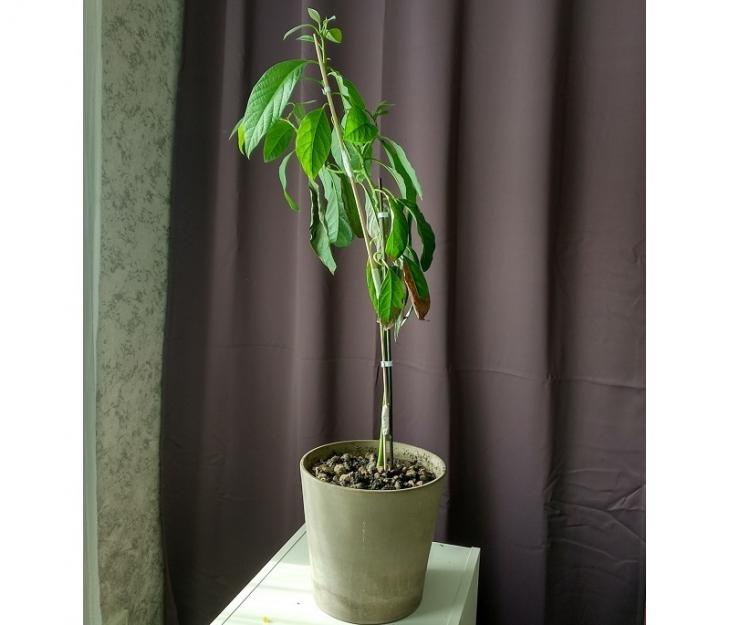

Photo: my avocado also needed support, otherwise the trunk stubbornly tilts to the right
What kind of soil to prepare
Choose a well-drained and fertile soil for your avocado. You can prepare a soil mixture in the following proportions:
- 2 parts of turf land,
- 1 part sand
- 1 part humus.
Or: leafy earth, peat and sand in equal proportions.
When buying or preparing potting mix for planting avocados, keep in mind:
- The soil should be ventilated, fertile, loose, well retaining moisture;
- The soil should not be acidic
- The content of wet moss and sand in the soil mixture will love the avocado.
| BTW My avocado grows in regular garden soil. At the bottom of the pot, I generously laid the drainage (at least 2/3 of the volume). I mulched the top layer of soil with pebbles - this mulch looks both decorative and retains moisture. Although the best moisture-saving mulch for avocados is moss or rock chips. In addition, mulch protects the wet soil from the dominance of house flies, especially during the cold season. |
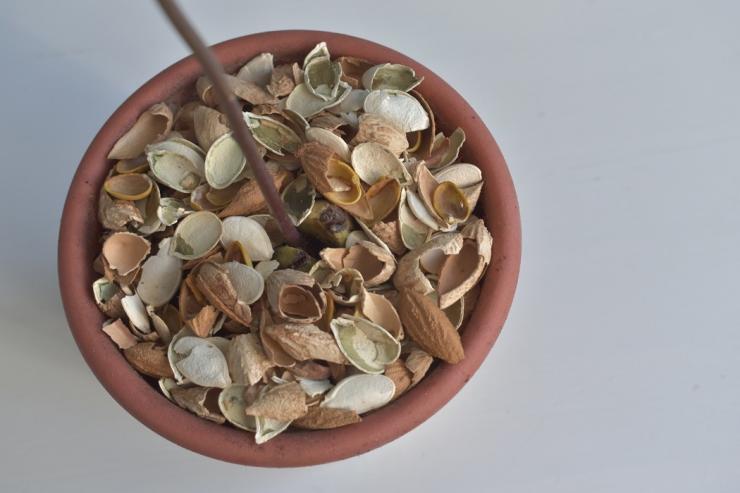

Photo: mulch from shells of nuts and pumpkin seeds
Pests and diseases
Pitted avocados may dry out or lose their foliage. The reason for this condition may lie in the high air temperature. This condition is also observed at low temperature conditions. The condition of the plant is affected by watering, it can be excessive or insufficient. Homemade avocado suffers from drafts. Therefore, the pot with the plant should be placed in a place protected from drafts.
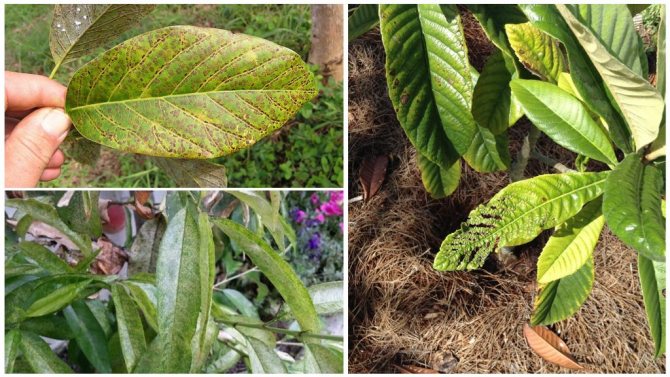

Avocado diseases
If the tips of the foliage turn brown or the leaves fall off, then the air in the room is dry. The situation is corrected by regularly spraying the plant with a spray bottle. A similar situation happens when homemade avocados are water-scarce. Proper watering will correct the situation.
Central heating can also damage the flower. To make the plant suffer less from dry air, the pot is placed on a pallet with sphagnum moss or moistened expanded clay.
When the leaves lose their brightness, become pale, it means that the plant receives little light. Move the avocado closer to a window or provide lighting.
Indoor avocado can damage:
- spider mite;
- shield;
- powdery mildew.
You can get rid of pests with soapy water, treating problem areas or using insecticides such as Aktara, Fitoferm, Aktellik, Biotlin, Calypso, Confidor.
Insecticides should be used as a last resort and only with severe damage.
The nuances of growing
Avocado is a member of the laurel family. Under natural conditions, it can reach eighteen meters in height. So it can be called a tree very conditionally. But at home, in any case, it will not grow like that, but it will be a very cute and spectacular mini-garden.
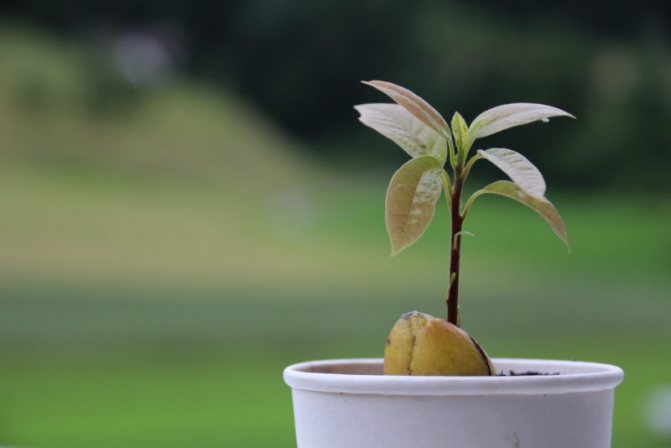

The main condition for seed germination is ripe avocado.
The first prerequisite for successful avocado development is choosing the right fruit. It should be ripe, since the fruit seed runs the risk of not sprouting, and slightly puckering when pressed.
The next moment - you need to be able to get the bone. Again, it depends on this whether the plant will hatch.
How can this be done?
- Make a neat cut lengthwise.
- Grab the halves with your hands and scroll them in opposite directions.
After which the bone is very easily removed.
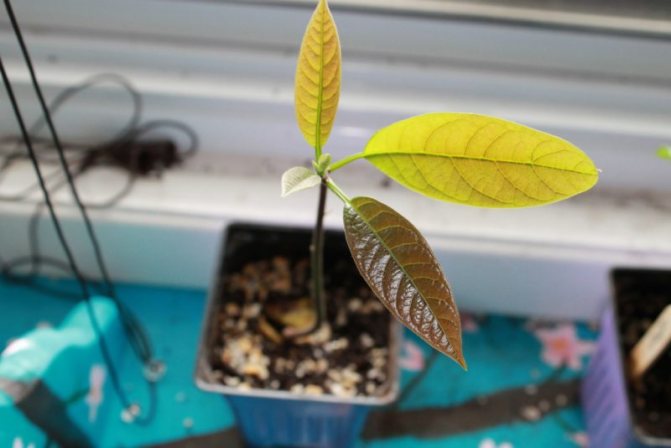

Avocados require special attention.
You need to be prepared for some nuances:
- a very young tree is not particularly attractive. It looks like a thin bare stem with a bunch of leaves on the very top;
- the sprout vitally needs direct rays of the sun, otherwise you should not expect normal development;
- in winter, you will have to make a lot of efforts to save the green pet and prevent it from shedding its leaves: ensure the air temperature is not less than +16 C and do not water often;
- does not tolerate dry or too wet soil, but requires high humidity.
Some interesting facts
- Avocado is in the Guinness Book of Records. He got into it for its nutritional value, which is recognized as the highest among fruits;
- Among the Aztecs, this fruit symbolized love, for the reason that the fruiting of this tree is impossible without another one of the same standing nearby. It turns out something like a married couple.
- The most popular variety of this fruit is called Hass, because it was discovered by the American postman Rudolf Hass, who discovered a fruit tree in his own yard back in the 30s of the last century. The fruit was so tasty that he immediately filed a patent for it. This is how the avocado variety appeared, which has become the most popular in the world. And the unique tree, they say, still grows and bears fruit.


In which countries is it growing
When buying a fruit, you need to consider where the avocado grows and in which countries it is cultivated. Mexico is considered the birthplace of the fruit. The total area for growing fruit reaches more than 400 thousand acres.
The fruits are cultivated in the states of Puebla, Morelos, Nayarit, Michoacan, etc.
Avocado grows naturally in America (North, South), in the Canary Islands. The plant species has spread in the following countries with subtropical and tropical climatic conditions:
- Republic of the Dominican Republic;
- Peru;
- Indonesia;
- Colombia;
- Africa;
- Netherlands;
- Chile;
- Spain;
- Kenya;
- France;
- New Zealand;
- Belgium;
- Germany;
- Israel;
- Haiti;
- Australia;
- Philippines;
- Malaysia.
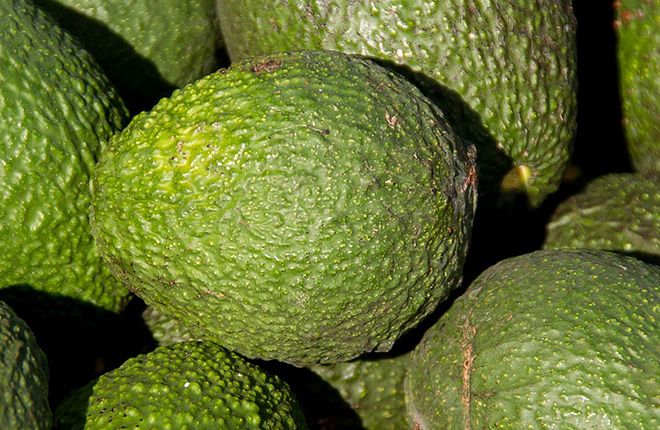

These countries produce more than 90% of the total world supply of avocados. The area of plantations on which crops are cultivated expands annually. The culture was also spread on the territory of Abkhazia, in Russia the plant is grown on the Black Sea coasts.
Chemical composition and content of nutrients
Avocados are rich in a variety of minerals and vitamins that the body needs to function properly. The pulp contains such important chemical elements as:
- magnesium;
- fluorine;
- selenium;
- calcium;
- potassium;
- manganese;
- copper;
- iron.
Ripe fruit pulp contains many vitamins. For example, folic and ascorbic acids, retinol, riboflavin, tocopherol, vitamin K. Also, the berry contains large amounts of fats that are important for the human body. Oleic acid helps to reduce blood cholesterol levels, which helps to improve the health of the heart and blood vessels.
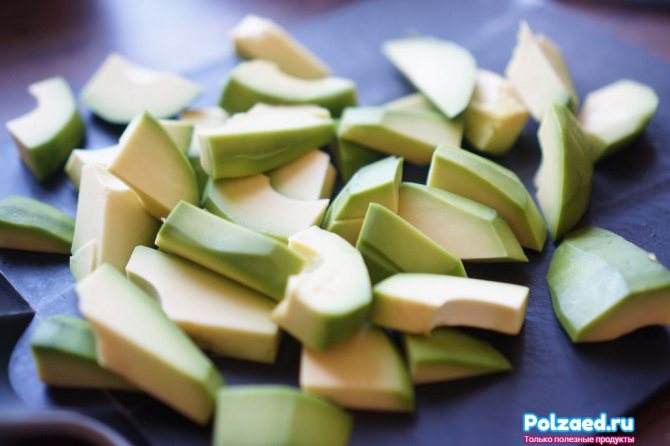

back to menu ↑
Rules for choosing ripe fruit
Ripe exotic fruit has a very delicate and pleasant taste and sweet smell. Unripe fruits contain much less valuable and useful substances for the body. Inspect avocados carefully before purchasing. Pay attention to 3 criteria for fruit ripeness:
- Avocado appearance. The skin of the fruit should be free of stains and damage. The color must be uniform;
- Softness. Try applying a little pressure to the skin with your finger. If the fruit is unripe, it is dense and does not lend itself to deformation from pressing. If the fruit is overripe, a dent is formed that does not disappear. The fruit you need should be ripe, when you click on it, a dent will appear and almost immediately disappear;
- Fruit bone. Shake the avocado, if the fruit is ripe, you will hear the seed tapping inside.
Important! If you did buy an unripe avocado, it doesn't matter. Wrap the fruit in paper and place a few bananas next to it to help ripen quickly. There is one more way to "help" the fetus to ripen, for this you just need to live it in a warm place for 3 days.
Is it possible to get fruits at home and how to do it
Even if an avocado does have flowers when grown at home, the likelihood that they will set fruit is minimal. Only 1 in 5,000 flowers can subsequently become fruit. This is due to a very complex cross-pollination system. For an avocado to bear fruit, you must have at least 2 trees for cross-pollination. You can try to achieve the appearance of the fruit with a few manipulations. Each flower blooms twice. For the first time, only the pestle functions. Several of these flowers need to be marked. The next time they open up as male flowers. From these, pollen can be transferred to female flowers. Perhaps the result of cross-pollination will produce fruits.
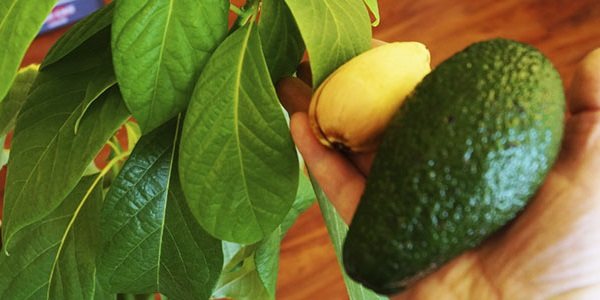

Planting a sprouted seed
After the seed has germinated, it must be transplanted.
To do this, perform the following actions:
- Choose a plastic container with a diameter of no more than 15 cm at the bottom there should be a sufficient number of drainage holes. Pour soil into the pot. Submerge the sprouted bone by a third into the ground.
- Place the container in a warm, well-lit place and water often. It is best to water through a tray, then the plant will take as much moisture as it needs on its own.
- Do not break off or remove the bone. This can damage the sprout and then the plant will die.
- Over time, the bone will become smooth and pinkish. It will grow and be a decoration for the tree.
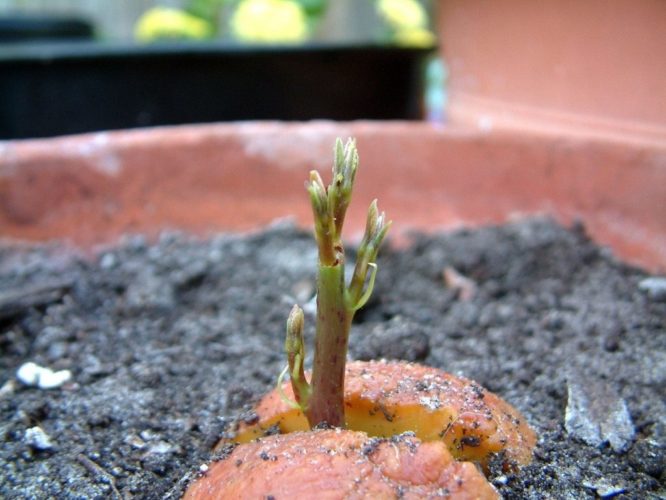

Which side to plant the avocado seed?
For any planting method, you need to place the bone with the tip up.
What to do after the first sprout appears?
After the first sprout appears, the length of which must be at least 3 cm, the plant must be planted in a pot.
Why avocado dream
Dream books interpret the appearance of avocados in dreams mainly as upcoming positive changes. So, planting a tree and caring for it is interpreted as an upcoming change of residence, or as a long trip, or as an expansion of the circle of friends. If the fruit itself is dreaming, then this is a frivolous act. Eating this fruit with a thick skin in a dream - you have to show character. Eat delicious fruit - to joy. With a large bone - you are overwhelmed with creative energy.
So it doesn't matter at all whether an avocado is a fruit or a vegetable. What is important is that this is a unique product with amazing beneficial properties.
Shoot or young plant avocado photo
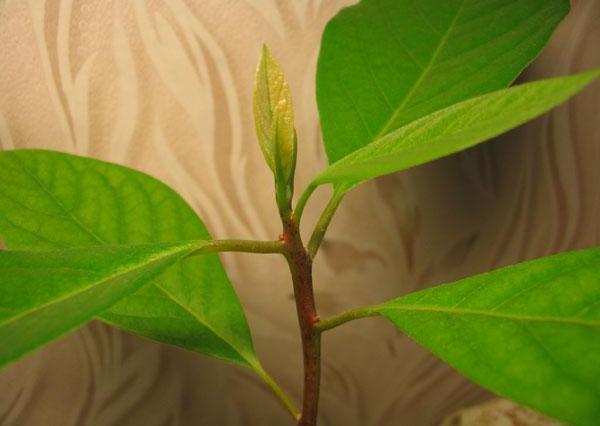

The avocado plant is a fast-growing tree that can reach 18 meters in mature age. The trunk of a tree is most often straight. Avocado branching is very strong. The leaves are constantly crumbling, which gives the plant a not very neat look.
Problems with growing avacados
In winter, the tree sometimes sheds its leaves, which reappear in the spring. He goes into hibernation. This is completely normal.
In the process of growing, problems arise:
- The tips of the leaves dry up. This happens when irrigation rules are not followed, air humidity is insufficient.
- Avocado does not like drafts - leaves fall. If you take it outside in the summer, then you need to take this moment into account. Lowering the temperature can also cause leaves to fall.
- Leaves turn pale in low light.
Failure to comply with the rules for care leads to the following conditions:
- the plant is more often exposed to diseases;
- the moment of fruiting does not come;
- the stems are stretched;
- the toxicity of the plant increases.
What conditions are needed for growing a tree at home
Avocado is a representative of the tropics. Therefore, in order to grow it at home, it is necessary to create appropriate conditions for it. The plant loves moisture very much. When the indoor air is dry, the leaves will begin to dry out. The wood also needs warmth. It is impossible for the room to be below + 10-12 degrees. It is necessary to put the pot with the plant in a bright place, but without direct sun, so that the leaves do not get burned from its influence.
At the beginning of development, the avocado grows very quickly. And in 3 months it can reach a height of 35-50 cm. Then growth slows down. Without outside interference, the side shoots will not grow, the tree will stretch out strongly, and, upon reaching the ceiling, will die. Therefore, the tip must be pinched to stimulate the growth of the lateral branches and form the crown.
During pregnancy
Avocado is indicated for pregnant women, regardless of the duration of pregnancy, since it has a beneficial effect on the condition of the fetus in the mother's womb, and on the future woman in labor herself.
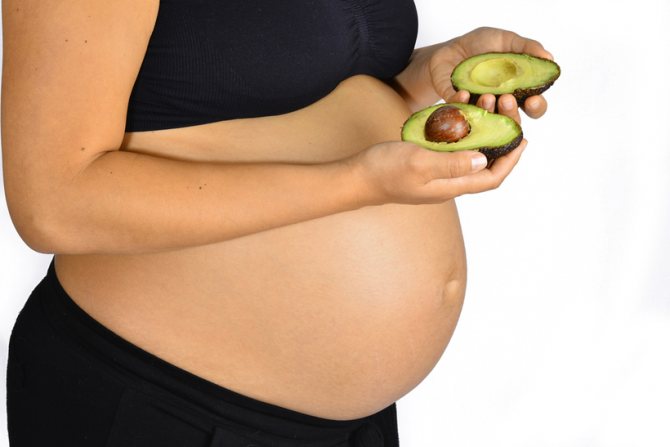

Moreover:
- Folic acid contained in avocado is able to prevent the occurrence of defects and pathologies in a baby;
- Prevents the possibility of developing anemia;
- Helps prevent dental problems that often haunt pregnant women;
- Since avocado is rich in unsaturated fats, it contributes to the normal formation of the fetal brain.
It is possible to continue indications for the consumption of this delicious tropical exotic by pregnant women. And there are many reasons for this:
- Lack of calcium in the body
- Exacerbation of toxicosis
- Vitamin deficiency, weakened immunity
- High blood pressure
- Chronic Gastrointestinal Disorders
- Cardiovascular diseases
When eating avocados, pregnant women should follow certain precautions. First of all, you need to make sure that the fruit, or one of its components, does not cause intolerance and is not an allergen. But even if everything is in order with this, then you should not abuse the exotic.



